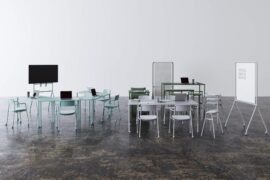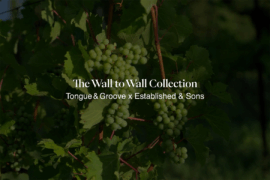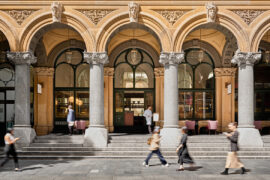Khai Liew’s masterful body of work is informed by his background as a conservator and dealer and framed by a practice characterised by collaboration.
These days there’s no talking about Khai Liew without making some sort of Indigo Slam reference. As far as downright jaw-dropping residential projects go, it doesn’t get much better than this one. The Chippendale home of White Rabbit Gallery founder and philanthropist Judith Neilson is a tour de force of material craftsmanship, light and sculptural form. But what makes it truly spectacular is the scale and scope of its furnishings, totalling 190 custom items each designed by Liew.
Sydney-based Neilson visited the Adelaide-based designer’s Norwood showroom one day, liked what she saw and mentioned they should do something together. When she eventually called Liew it was to invite him to help sort through her existing art collection. Soon after, on the suggestion of Neilson’s friend Penelope Seidler, she asked him to create all the furniture, lighting and soft furnishings for her as yet unbuilt new home.
The ambitious commission took Liew and his small team of craftspeople four and a half years to complete, with all of them dedicated to the job.
Everyone wants to know what the experience was like and Liew is the first to admit it was a once-in-a-lifetime opportunity, the likes of which he will never see again. Despite this, his approach was the same as it has been since he established his studio in 1996. As Liew explains, “The foundations of my practice haven’t changed. My work is still all about material and responding to place, climate or a client.”
Indeed, his response to Neilson involved peeling back the layers of her public identity to reveal a private person, with the majority of his resulting designs a delightfully orchestrated subterfuge.
“I thought the most important thing in this palatial home was joy and laughter and what better way of bringing joy and laughter into a home than having grandchildren visit. So, in a quietly devious way, I made all these items of furniture that would bring Judith’s grandchildren to the house – an Alice in Wonderland chair, a sunflower chair, penguin side table and Shaun the Sheep lounge chair. They’re all things that adults wouldn’t have a clue about, but kids understand the language,” he says with a smile.
Spend any amount of time with Liew and it quickly becomes apparent that one of the country’s most renowned designers has a gentle sense of humour that underscores everything he does, not to mention a warmth and generosity permeating all aspects of his business. He also has a gift for storytelling and loves nothing more than to bring people together.
Unsurprisingly, collaboration is core to his practice and provides the framework for not only his commissions, but his exhibition, competition and interior design work too. These professional relationships are often ongoing, as is the case with Neilson, who also invited Liew to design her newest venture, the Phoenix gallery and performance space, a stone’s throw from White Rabbit Gallery. Liew, in turn, brought some of Australia’s finest on board, including John Wardle Architects and Durbach Bloch Jaggers, to help realise the cultural hub, due for completion late 2018.
Most recently, he again collaborated with Durbach Bloch Jaggers, along with Office of Ryue Nishizawa, on their shortlisted entry for the Adelaide Contemporary design competition. While they didn’t win, it was arguably the most poetic expression of what’s possible for the city’s Old Royal Adelaide Hospital site.
Yet perhaps Liew’s most significant collaborative undertaking to date is the Collec+ors exhibition, held at the Art Gallery of South Australia in 2010, which then toured to the London Design Museum the following year. The exhibited work was nothing short of a craft lover’s dream, comprising furniture pieces jointly designed by Liew and six other Australian artisans. These exquisite pieces, including the elegant Bruce cabinet on stand, featuring ceramicist Bruce Nuske’s sgraffito-designed stoneware panels, exhibit Liew’s signature fine detailing, clean lines and sensual forms and are undeniably more art object than everyday furnishings, such is their beauty.
Collec+ors was also very much a personal homage to South Australian artists, from whom Liew draws his inspiration. “I learn so much from working with people like Bruce, Jessica Loughlin, Julie Blyfield and Kirsten Coelho,” he explains. “It’s important to do our own thing and so I’m inspired by these artists and how they see our place; the local culture and it’s various physical and social manifestations.”
While looking in rather than out is an idea Liew first explored in a keynote address at 2002 Designing Futures symposium in Perth, it’s by no means his only source of inspiration.
His is a body of work richly informed by an expert’s knowledge of design history developed during years spent working as a conservator and dealer specialising in Colonial furniture. Liew learnt about the period’s construction techniques and about the transference of ideas from places like the UK and Europe to Australia.
And when he began buying Danish furniture he started studying mid-century furniture construction as well, all of which led to his first commission by then Art Gallery of South Australia (AGSA) Director Ron Radford for a series of gallery benches. It was closely followed by Liew’s first solo exhibition at JamFactory in 2001, titled Long Weekend, and then his more recent entry for the 2015 Rigg Design Prize at the National Gallery of Victoria.
Rigorous standards of excellence in construction and aesthetic with a meticulous attention to detail still holds true for Liew today. It’s especially evident when visiting his workshop, a modest space a few doors down from the showroom and set back from the street, making it easy to miss.
Liew’s team of up to eight craftspeople create life-size models based on his sketches and together they scrutinise every single plank of timber. It’s a very hands-on process, which translates eloquently into the final product.
Liew is currently finishing the interior design of a home in North Adelaide and also preparing for a major solo exhibition at the AGSA next year. Both projects contribute to his work’s awareness of where it sits within the broader history of design, while delivering more high-end design outcomes that are as technically proficient as they are beautiful.
INDESIGN is on instagram
Follow @indesignlive
A searchable and comprehensive guide for specifying leading products and their suppliers
Keep up to date with the latest and greatest from our industry BFF's!

Welcomed to the Australian design scene in 2024, Kokuyo is set to redefine collaboration, bringing its unique blend of colour and function to individuals and corporations, designed to be used Any Way!

Rising above the new Sydney Metro Gadigal Station on Pitt Street, Investa’s Parkline Place is redefining the office property aesthetic.

London-based design duo Raw Edges have joined forces with Established & Sons and Tongue & Groove to introduce Wall to Wall – a hand-stained, “living collection” that transforms parquet flooring into a canvas of colour, pattern, and possibility.

In Australia alone, 6.4 per cent of all waste generated comes from furniture and furnishings. In this article, we review today’s most impactful Whole Of Lifecycle Furniture practices.

Congratulations to Kerstin Thompson, 2023 recipient of the Australian Institute of Architects’ Gold Medal. We revisit Kerstin’s many accomplishments, among them being named an INDESIGN Luminary.
The internet never sleeps! Here's the stuff you might have missed

Carr’s largest residential project to date integrates concrete, steel mesh and landscape across 122 apartments in Melbourne’s Brunswick.

Luchetti Krelle’s timeless design at Epula marries heritage grandeur with classic sophistication, celebrating the spirit of a European piazza whilst remaining unmistakably of its place.